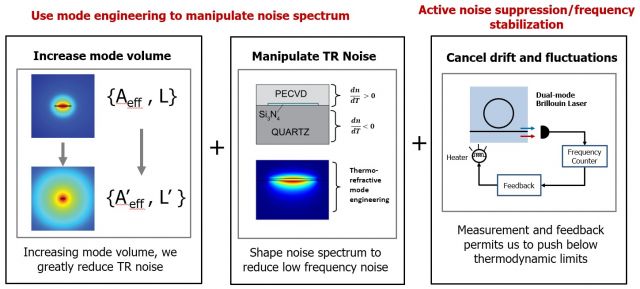Integrated optical frequency references
Optical reference cavities play an important role in laser frequency stabilization, which has wide applications in optical communication, atom cooling and spectroscopy. Frequency locking utilizing the Pound-Drever-Hall technique requires reference resonators to be of high-finesse and be immune to thermal fluctuation. Planar optical reference cavities pave the way toward fully integrated on-chip frequency stabilization system, making it possible to have ultra-narrow-linewidth laser-on-a-chip system. However, integrated optical reference cavities suffer more from the thermodynamic fluctuations compared to their bulky counterparts due to non-zero thermo-optic coefficient and thermal expansion coefficient, and the small mode volume can further worsen performance. Hence it is important to design the integrated resonators to achieve thermal stability on par with or better than that of discrete cavities.

To improve the thermal stability of the resonator, we use three methods: mode volume expansion, thermorefractive engineering, and active temperature sensing. Temperature fluctuations scale inversely to mode volume, thus using a diluted mode with long cavity length can effectively reduce the thermal equilibrium noise as well as photothermal noise. This can be achieved by our high aspect ratio waveguides which are in favor of large mode area. Using crystal quartz, which has a negative thermo-optic coefficient, we can engineer the thermo-optic coefficient (TOC) of the waveguides. We achieved 1.15×10-6/K effective TOC of a Ta2O5-core crystal quartz-substrate waveguide, significantly smaller than those of the waveguide composition materials. The resonator is predicted to have a temperature fluctuation of 3.7 uK and a fractional frequency fluctuation of 2.73×10-12. The waveguide made of this core/cladding system has a measured propagation loss of 1.13 dB/cm, and a loaded Q of 1.95×105 is obtained from a 1.6 mm radius ring resonator.

Active temperature sensing can be realized by measuring the resonance shift with respect to temperature. Multiple modes can circulate inside the cavity (e.g., TE and TM modes), and they have different effective TOCs. When temperature changes, their resonance frequency will vary distinctively which can be used as an indicator for temperature fluctuation. By measuring the resonance difference between different modes, the local temperature can be actively monitored and the signal will feedback into the thermal control to actively stabilize the cavity.